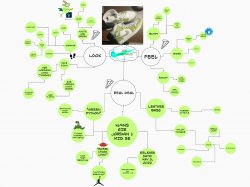
In ARFD102: Drawing as Research, Professor McGuire utilizes mind mapping as means to broaden students’ approach to sketching. Prior to sketching a figure of their choice, students are tasked with creating a mind map about their chosen object. In a short mini-lesson, Professor McGuire advised students on how to utilize words, sentences, questions, images, color, and organization in their mind map in order to creativly analyze their objects. Students then utilized a free mind mapping tool to generate their mind maps and share with Professor McGuire. Mind maps, as in ARFD102, can be utilized as means to encourage critical analysis and “deeper-dives” into content. Mind mapping can also be used as a means to enhance recall, synthesize information, and collaborate with peers.
Mind Mapping is a strategy that helps students visualize and analyze difficult concepts. Starting with a prompt or topic, students identify supporting themes or subtopics and illustrate connections using branches, color, and illustrations (or other media). Mind maps are great for organizing thoughts and ideas related to subject matter but can also be used to help analyze and critique material, encouraging deeper thinking and understanding of difficult concepts.
